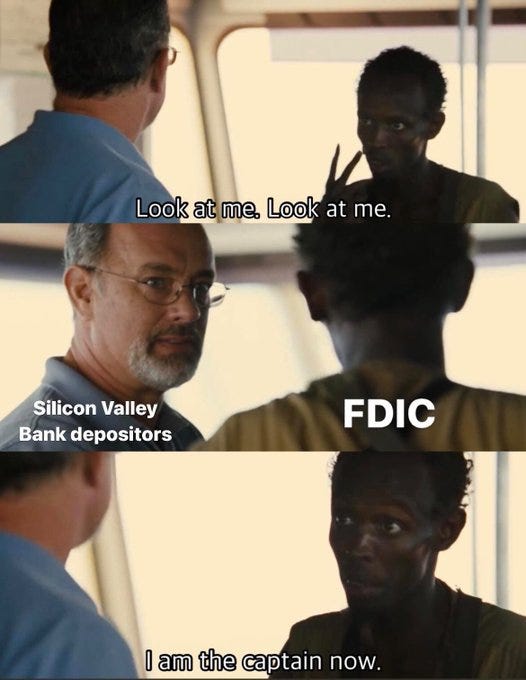Perspective on Risk - March 10, 2023 (Yes, Banks Fail)
Banks Fail; Regulatory Miss? No Contagion; FHLB (WTF); It’s Never Good To Win These Awards
OK. Too many questions and emails, so I guess I need to write this. Comes with being the former regulator guy. This doesn’t interest me as much as all the pundits begging/pleading/rending of garments that’s going on in the press. All of the pearl clutching bores me. Honestly, this isn’t even the most interesting thing happening today1.
Anyhow…
Crypto is a sideshow
PE/VC is the appetizer course
The main dish, commercial real estate, is yet to come.
Banks Fail
The optimum number of bank failures is > 0. Ideally banks would fail for idiosyncratic reasons.
We’ve seen several banks fail recently.
The Crypto Banks
Silvergate Bank (SI)
SI was a major custodial bank for the crypto industry. They operated the SEN network to facilitate the movement of funds between cryptocurrency exchanges and other crypto businesses. When a customer wants to move funds from one exchange to another, they can use the SEN network to instantly transfer funds between their accounts at different exchanges.
As a result, SI held significant demand deposits. They invested these deposits at term (I think they had a duration of around 3.5). Rates went up, the value of the assets went down, the deposits flowed out, SI then borrowed ~$4B from the FHLB system, delayed filing their 10-K and announced that they may not be able to remain a ‘going concern’, and when the run continued SI entered into voluntary liquidation under the oversight of the California Department of Financial Protection and Innovation. That they went into liquidation means no one was willing to buy the firm.
Frances Coppula has a nice summary Silvergate Bank - a post mortem
No doubt FDIC did try to find a buyer. That's how it usually resolves failing banks. And the little that journalists managed to get out of FDIC officials and Silvergate employees suggests that for a while, they had some hope. FDIC probably tried to persuade other banks and financial institutions to take on this deeply distressed bank as a going concern.
Simple lesson is you can’t back volatile DDA with term assets without material risk.
The VC Banks (and/or banks with HTM Securities Holdings)
Silicon Valley Bank (SVB)
This is a bit more interesting. SVB is a rapidly growing niche bank that specializes in serving the needs of technology and life sciences companies, often early stage companies. SVB lent against non-public shares typically involves providing loans to individual shareholders or to the company itself, using the shares as collateral. SVB also took significant deposits from these companies and from the VC firms that backed the firms.
SVB almost doubled in size between 2020 and 2021, going from total assets of $116B to $212B.

There appear to have been a number of problems here.
Deposits grew from $61B at Q419 to $189B at Q421. Loans doubled during this period to $66B and the securities portfolio peaked at $126B.
Non-public companies have been under stress with the Fed raising interest rates. They’ve been burning through their funds (reducing SVB’s deposits) and in some cases going out of business. The market value of these private equity positions has clearly materially fallen. This of course affects the value of SVB’s assets, and would force them to raise their allowance for loan losses.
As interest rates rose, the value of their securities portfolio deteriorated. They held some $99B of securities as ‘held to maturity’ which meant they did not mark the positions down through the income statement. I have read (but not confirmed) that most of this position was agency mortgage backed securities (oops). For the non-finance folks in the audience, these securities are ‘negatively convex’ which means that when rates rise they lose value at an increasing rate. This is because homeowners are less likely to pay off their mortgage early.
SIVB has tried to do a capital raise, but didn’t succeed. There is information content there.
On Thursday, the FDIC released the 4th quarter banking statistics: FDIC Quarterly Banking Profile and bank call report statistics were downloaded by all of the Wall Street firms, etc..
The sell-off on Thursday came just days after data from the Federal Deposit Insurance Corporation, a banking regulator, showed US lenders were sitting on roughly $620bn of combined unrealised losses in their securities portfolios.2
The disclosure here in the regulatory filings is pretty hard to find; you have to look at the Interest Rate Risk Analysis as a Percent of Assets section of the UBPR. For SVB, this shows that the unrealized depreciation in the securities portfolio went from 6.7% of Tier 1 capital a/o 9/30 to 89.2%. (oops again). Hard to get much value when lending against these securities.

So the proximate cause was unrealized losses on the securities portfolios. But again, this is just what pushed them over the cliff; fails in the business model and the Fed raising rates did them in.
The bank didn’t make it to the weekend, so the FDIC could resolve over the weekend (the old way). The run was too quick. They saw $42B run at the close of business yesterday. So the California Department of Financial Protection closed the bank during business on Friday, and the FDIC transferred the insured deposits to a receiver bank. However, insured deposits make up a tiny portion of the deposit base. Uninsured deposits may well end up haircut (the new way). Welcome to enhanced market discipline; this is how Congress wanted things to work.


SVB is not considered systemically important.
Now again there has been much sturm-und-drang that the poor startup companies will not be able to meet payroll. More likely, this is the VC firms using this as a canard to try and protect whatever of their Fund’s deposits remain at SVB. Presumably there is some value left; if the loan portfolio is actually reasonably marked uninsured depositors may even get out whole. Here is the key paragraph from the FDIC release:
All insured depositors will have full access to their insured deposits no later than Monday morning, March 13, 2023. The FDIC will pay uninsured depositors an advance dividend within the next week. Uninsured depositors will receive a receivership certificate for the remaining amount of their uninsured funds. As the FDIC sells the assets of Silicon Valley Bank, future dividend payments may be made to uninsured depositors.

Other banks with 1) significant unrealized losses, and/or 2) significant VC money and that lend on private shares are now under scrutiny. Go figure.
Morningstar has published its candidate list3:
To be clear, the US bank has failed. The Bank holding company and the UK bank remain in operation (at this writing).
Lessons:
Rapid growth and a higher risk business model
Run your damn business on an economic, not accounting or regulator, basis
Deposits highly correlated with assets; wrong-way risk
Wholesale funding is highly runnable
Failure to raise capital
The new post-GFC resolution regime is in effect
Regulatory Miss?
Interestingly, it does NOT look like SVB was on the FDIC’s problem bank list; the assets of the banks on the list was $50B in 1Q22, jumped up by ~$120B for a few quarters before reverting; SVB had total assets of >$200B during this period. Sid, I changed my mind, it seems like a regulatory miss.
Interestingly, this is the 2nd largest bank failure in history, after WaMu. But due to inflation, growth and a different environment, not nearly as troublesome.
No Contagion
Odds are there is little contagion here. For a bank failure to bloom into a full scale systemic event you need linkages between leveraged firms. It doesn’t look like there is much of that here. Some will claim that depositor haircuts could be systemically contagious, but everyone has told me that the VCs are sitting on large piles of cash. Yes, their investors may lose money, but that will take time and be widely distributed.
FHLB (WTF)
Can we talk about the FHLB? What the hell are they doing funding either Silvergate or Silicon Valley?
The FHLB has frequently been called the ‘lender-of-next=to=last=resort.’ Because of the stigma from borrowing under the Discount Window, banks much prefer to borrow from the FHLB system.
Now each of the FHLBs operate separately, and some of them have a higher risk tolerance than others; guess which get the business?
The FHLB System was chartered by Congress in 1932 with a primary mission of providing member financial institutions with financial products/services which assist and enhance the financing of housing and community lending. What part of lending to crypto-adjacent banks, or banks that predominantly lend to, and hold deposits from, venture capital firms and their spawn is within this mission?
Both Silvergate and Silicon Valley Bank borrowed from the FHLB-San Francisco.
Just A Reminder That It’s Never Good To Win These Awards
I got scared every time someone I was associated with won an award. It just meant a comeuppance was around the corner.












